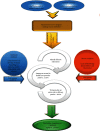A Model of Trust within the Mother-Midwife Relationship: A Grounded Theory Approach
- PMID: 33144861
- PMCID: PMC7599398
- DOI: 10.1155/2020/9185313
A Model of Trust within the Mother-Midwife Relationship: A Grounded Theory Approach
Abstract
Introduction: The mother-midwife relationship is a good experience during childbirth, but there is a lack of evidence about the trustful relationship between mothers and healthcare providers during labor and birth in Iran. The current study aimed to discover how a trustful mother-midwife relationship is formed during a vaginal delivery.
Methods: Twenty-nine women who had a vaginal delivery, midwives, and obstetricians participated in this qualitative research with the grounded theory method. Data were collected using semistructured interviews and observations. Open, axial, and selective coding was used for data analysis. Findings. The main category of "seeking trust in midwife" and three subcategories of "effective interaction," "attempt to access to healthcare provider", and "playing an active role in birth" were extracted from the data.
Conclusion: According to the findings, mothers tried to gain action/interaction strategies and increase healthcare providers' trusts during vaginal delivery. It is essential to consider the factors that improve or disrupt this relationship.
Copyright © 2020 Firoozeh Mirzaee and Mahlagha Dehghan.
Conflict of interest statement
The authors declare that they have no conflicts of interest to reveal.
Figures
Similar articles
-
The kaleidoscopic midwife: A conceptual metaphor illustrating first-time mothers' perspectives of a good midwife during childbirth. A grounded theory study.Midwifery. 2016 Aug;39:103-11. doi: 10.1016/j.midw.2016.05.008. Epub 2016 May 13. Midwifery. 2016. PMID: 27321727
-
The supporting role of the midwife during the first 14 days of breastfeeding: A descriptive qualitative study in maternity wards and primary healthcare.Midwifery. 2019 Nov;78:50-57. doi: 10.1016/j.midw.2019.07.016. Epub 2019 Jul 15. Midwifery. 2019. PMID: 31357116
-
Intrapartum Care and Experiences of Women with Midwives Versus Obstetricians in the Listening to Mothers in California Survey.J Midwifery Womens Health. 2020 Jan;65(1):45-55. doi: 10.1111/jmwh.13027. Epub 2019 Aug 26. J Midwifery Womens Health. 2020. PMID: 31448884 Free PMC article.
-
Intrapartum care in the twenty-first century.Nurs Clin North Am. 2002 Dec;37(4):771-9. doi: 10.1016/s0029-6465(02)00022-1. Nurs Clin North Am. 2002. PMID: 12587374 Review.
-
What is a good midwife? Insights from the literature.Midwifery. 2014 Jan;30(1):3-10. doi: 10.1016/j.midw.2013.06.019. Epub 2013 Jul 26. Midwifery. 2014. PMID: 23891303 Review.
Cited by
-
Rethinking trust in the context of mistreatment of women during childbirth: a neglected focus.BMJ Glob Health. 2022 May;7(5):e009490. doi: 10.1136/bmjgh-2022-009490. BMJ Glob Health. 2022. PMID: 35606016 Free PMC article. No abstract available.
-
The Role of Midwives in the Course of Natural Childbirth-Analysis of Sociodemographic and Psychosocial Factors-A Cross-Sectional Study.Int J Environ Res Public Health. 2022 Nov 28;19(23):15824. doi: 10.3390/ijerph192315824. Int J Environ Res Public Health. 2022. PMID: 36497898 Free PMC article.
-
The relationship between Iranian women's perception of their birth team's compliance with medical ethics and their perception of labor pain.BMC Pregnancy Childbirth. 2024 Jan 20;24(1):70. doi: 10.1186/s12884-024-06269-6. BMC Pregnancy Childbirth. 2024. PMID: 38245719 Free PMC article.
-
What do we know about midwife-woman interactions during vaginal childbirth: a scoping review and thematic analysis.BMC Pregnancy Childbirth. 2025 Aug 25;25(1):882. doi: 10.1186/s12884-025-07973-7. BMC Pregnancy Childbirth. 2025. PMID: 40855413 Free PMC article.
References
LinkOut - more resources
Full Text Sources


